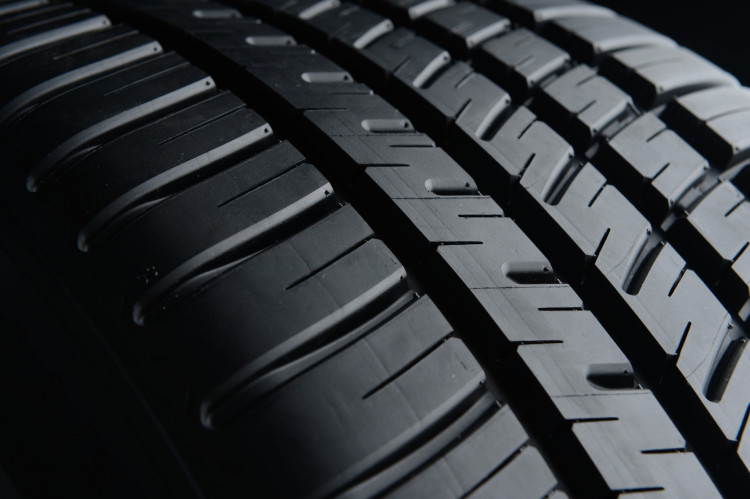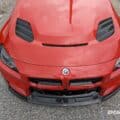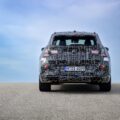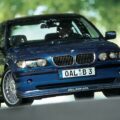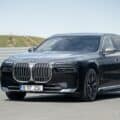It’s a brave tire company that invites a throttle-happy group of auto journalists – a good number with racing experience – to torture test their new tire against the competition on a wide-open racetrack. Braver still, is a company that invites these journalists to compare their new tire in a competitive pool of tires in which it is out-classed.
Michelin’s Pilot Sport All-Season 3 is, as its name suggests, an all-season tire – but this tire was pitted against summer Ultra High Performance (UHP) tires from the competition through an autocross. My initial impression upon learning of the apples to oranges test was that these tire reps were either out to lunch or incredibly sure of their product. It turned out to be the latter.
I’ve never fancied Michelin. As a devoted Ferrari F1 fan through the 1990s and early 2000s, I was naturally a disciple of Bridgestone. The Japanese tire company had literally embedded a gaggle of tire engineers inside the Maranello factory and Ferrari had likewise embedded race engineers in Bridgestone’s F1 development center in Japan. How cool is that?
Michelin, on the other hand, were supporting the evil (and devilishly fast) Fernando Alonso, who was racing wheel-to-wheel with my darling and highly contentious driver, one Michael Schumacher, whilst driving a Renault. Really, it was a tire race, and Michelin were consistently out performing Bridgestone in the early part of the 2005 season. But, as an adolescent testosterone-fueled F1 fan, these victories over Bridgestone only annoyed me. Maybe it was Alonso’s Fabio hair. Oh, the follies of youth. Regardless, I was forced to recognize Michelin’s engineering competence in the world’s premier class of motorsport.
Then, on June 19th 2005 at the US Grand Prix held at Indianapolis, Michelin screwed up royally. They did not do sufficient R&D to run their tire under the severe loading of the banked Indi circuit. A tire failure befell Ralf Schumacher, sending him crashing into the wall at extremely high speed – it was a scary and dramatic accident for the Toyota factory team. Others on Michelin tires suffered similar failures and Michelin themselves deemed the tire unsafe to run. To their credit, they swallowed their pride and put driver safety in front of publicity and racing results.
Michelin suggested adding a chicane to slow the particular corner causing problems for their tire, but this was roundly rejected by all Bridgestone equipped teams on the basis that Michelin was trying to change the rules to even the playing field because they showed up unprepared with an inferior tire. It’s not like it was their first time racing at this circuit – they’d been supplying F1 there since 2001. I recall the politically charged energy of that race – you could cut the air with a pit sign.
Ultimately, the FIA race stewards ruled that the course must remain as-is, and the Michelin teams should enforce their own reduced speed limits through that section of the track. It was a deathblow to Michelin at that race; they were dead-last if they did, doomed if they didn’t. They decided to enforce their own abstention from the race, pulling every team out after the parade lap. Since the majority of the field were sporting Michelin tires, this resulted in a one-horse race between the two Ferrari cars, while the Minardi and Jordan teams added color to the circuit whilst getting lapped by the Ferraris. It was a truly abysmal race, and one of the most controversial in the history of Formula 1. In the end, the race marshals were left to clear trash thrown on the circuit by angry American fans.
The above unsavory memory lingered on into adulthood and while my unrelenting pessimism against the brand was unfounded, like a brainwashed child who carries his indoctrination throughout his lifetime, I was left simply snubbing the brand – never driving on Michelin products unless they were already installed on press cars handed to me.
While it’s true that Michelin failed to develop a safe, fast tire for the 2005 Indianapolis GP and ultimately ruined the race for their teams and their fans, this was a singular event that happened nearly a decade ago and the rest of that season they were on the pace, competitive, and ultimately victorious, finishing with the constructor’s and driver’s crown. Michelin had unequivocally established their technical prowess and racing dominance in the most technologically challenging and fastest-changing realm of motorsport. Only a childhood grudge could hold one race against them – but so it did.
This sufficiently sets the stage for my tire test: I was invited by a company I don’t like to test a tire belonging to a category I detest: jack of all trades, master-of-none-all-seasons. I begrudgingly lugged my suitcase to the airport, dragging my feet in despair at my unsavory assignment. This is roughly where the pain stopped. Well, actually it was at some point after American immigration, which is a real b!+@# these days (“Can I please have my shoes back?”). Alas, I arrived in temperate New Orleans for a meal with the Michelin man, and his friends.
The men and women of a company often tell a lot about the product. I say this with no reservations: I’ve never been to a more jovial, relaxed and down-to-earth press event. The Michelin folks really know how to party, and the invited guests comprised a great group. What I saw consistently shining through was an unwavering dedication to the product – passion for the product. Could a tire company really inspire its employees to be so enthusiastic about their product? It was as if they all drank the Kool-Aid. I got my drinks directly from the bar.
The following morning we set off for Nola motorsports park, a brand-new multi-million dollar race circuit built a short drive from the heart of New Orleans’ Marti Gras party district. I spotted the circuit from the airplane on final approach and felt just a little bit giddy at the sight of it.
The New Michelin Pilot Sport All-Season 3
There were four main tests completed at the Michelin tire event. The first test was completed through an autocross course; as mentioned at the opening, Michelin allowed us to compare their newest Pilot Sport All-Season 3 tire against dedicated summer performance tires from several competitors including Pirelli, Bridgestone and Continental. The tires were fitted to several Subaru WRX STI sports cars sitting idly by.
First up was the Michelin to set the performance bar for our frame of reference. Initial impressions were as follows: “Consistent and progressive break-away; lots of grip when cold; excellent steering feel and accuracy for a street tire though more vague than dedicated track tire or streetable track tire.” The tire felt good and allowed the STI’s personality to flourish – but I was sure that the summer performance rubber of the competitors would easily embarrass Michelin’s all-season. I mean – how could they not defeat an all-season tire through an auto slalom on a serious sports car?
One by one, astonishingly, each competitive tire fell on its sword. I regret that I did not bring a chronograph or GPS-based data recorder to time each tire’s lap – this would have served as objective proof of the Michelin’s superiority, and without objective data it’s all touchy-feely observations. But that said, it was clear as day which tire was both fastest through the course, and most controllable. The Michelins had more total grip, they allowed for later braking points and clung to the tarmac with greater ferocity.
The Pirelli P2 Nero felt just a shade behind the Michelin in every category considered: out of 5 stars awarded for total grip, steering feel and accuracy, and progressiveness at break-away I gave the Italian rubber 4 stars across the board where the Michelin set the bar in every category with 5 stars.
The Continental Extreme Contact DW seriously lacked overall grip by comparison to the others – it was a much slower tire through the course and caused the STI to suffer additional understeer. I gave the Conti a 3.5 for total grip, 4.5 for steering and 5 for progressiveness at the limit.
The Bridgestone Potenza (exact model name missing from my notes! – it was a summer performance tire but far less aggressive than the excellent RE-11) felt great all-round but had less total grip than the Michelin. I gave it 5 stars save for total grip, where I assigned it a score of 4 out of 5.
Ambient temperatures were on the cool side, around 55 degrees Fahrenheit. I suspect this favored the Michelin, which was designed with a cooler operating temperature window in mind, but after sustained hard-lapping through the autocross the Michelins held up well and did not get “greasy” after heating them up and punishing them. It would be good to test the Pilot Sport All-Season 3 again under very hot track-day conditions. I strongly suspect it would maintain its performance advantage but perhaps hotter temperatures would slim the gap over the others. Of course, for most parts of the U.S.A. and Canada cool temperatures are a regular part of real world driving – why should a chilly afternoon ruin the fun on your favorite back-road?
The second test was held on the race circuit courtesy of Cadillac’s CTS sedan; we were able to get a feel for high-speed stability, agility and feedback. The third test brought us out to a wet autocross with tires shod on Audi’s all-wheel-drive A4, and the final test allowed us to test wet and dry straight-line stopping distances. Test after test, the PSAS3 demonstrated more grip and control than any other tire present. The latter three tests compared the Pilot Sport A/S 3 against fellow all-season tires, and what then shone through was the tire’s superior comfort and noise characteristics. Where the competitors’ all-seasons were howling and at times screaming for mercy – the Michilens just got on with the job, comfortably.
To the objective data captured: the Pilot Sport A/S 3 managed a wet braking distance from 50 mph to 0 in 121 feet, and my Infiniti G37 sedan managed the shortest dry stop distance of the day at 111.1 feet. The next closest competitor, the Goodyear Eagle GT, did a 115.0 foot dry stop and worst-in-class 136.5 foot wet stop. The Yokohama AVID ENVigor managed a 118.8 foot dry stop distance and a wet distance of 127.3 feet. The Bridgestone Potenza GO19 brought up the rear with a 120.1 foot dry stop distance, and a second best wet stop distance of 124.1 feet.
That leaves the Michelin with a dry and wet stop distance 4 and 3 feet shorter than the next best competitors in class, respectively. It may not sound like much, but 3 or 4 feet can mean the difference between a collision or none – or a heavy collision and a light fender-bender, a severe or mild pedestrian injury. Stop times are critically important, particularly for less skilled drivers who are incapable of collision avoidance and know no other reaction other than slamming on their brakes.
To be clear: the Michelin Pilot Sport All-Season 3 completely blew my mind through the autocross when stacked against stiff summer-performance tire competition. The Michelin shouldn’t have won – but it did, and by a good margin. Unreal. It was very un-all-season-tire-like; as the old adage goes, “put that in your pipe and smoke it.”
To what does the Pilot Sport A/S 3 owe its impressive performance? Technology, of course. Michelin have figured out a way to saturate the rubber compound with great amounts of silica thanks to proprietary elastomer and binder technology. There is so much silica contained in the compound that Michelin have coined it, “Extreme Silica” technology. The tread design looks fairly run-of-the-mill but great attention has been paid to this design. The contact patch has been optimized under braking and cornering such that the patch dissipates heat more effectively across the tire’s diameter which keeps things cool and allows for more grip; tire sipes are interlocking to add stability while also offering additional malleability for wet and snow grip; and over 200 chemicals have been finely mixed into a secret-sauce recipe to deliver a tire that can operate in a very wide window of temperatures. A great deal of engineering has gone into what appear to be simple black circles.
What cars are well suited to the Pilot Sport A/S 3? From my time behind the wheels of a broad spectrum of cars at NOLA, it seems these all-seasons are best mounted on any car that is likely to encounter a mixture of hot and cold temperatures and dry and wet surfaces. The Michelin folks emphasized that these are considered 3 season tires – they are meant to extend the summer driving season deeper into the fall or winter in areas that get a lot of snow – but once there is deep snow, it’s best to switch to full winter tires.
These Michelins are not intended as track tires, though you’d have me fooled through an autocross. To call them all-seasons almost seems disingenuous – they are just too good at everything: it seems to defy the category, which normally is mediocre at everything and good at nothing. In short, these are all-seasons that perform like summer performance tires yet can bring you safely home through light snow and slush.
The Pilot Sport All-Season 3 comes in 65 fitment sizes accommodating the Fiat 500, Mercedes CLS 63 AMG, and everything in between.
I could see myself fitting these on nearly any BMW or MINI for street use while having R compounds at the ready for track day use. If you don’t do track days with your BMW or MINI but do enjoy pushing your car near its limits on curvy roads, these tires could strike a good balance between sport and all-weather driving safety, as well as good comfort and wear properties.
Michelin, I forgive you for the 2005 Formula 1 Indianapolis race debacle. The fact you mailed out two sets of F1 tickets in apology to everyone who attended the 2005 U.S. F1 race went a long way to prove the metal of the people behind the brand. But triumphing over Bridgestone to clinch the Driver’s and Constructor’s crown that season and experiencing the mind-blowing performance of these new category-defying all-season tires aren’t the only two events that won me over to the Michelin camp. There are two more experiences that readily come to mind.
I mentioned I’ve driven on Michelins when they’ve been handed to me on press cars, and just such a scenario unfolded in sunny Sevilla, Spain last summer. I was attending BMW’s international launch of the all-new M5 super-sedan, and it came factory-equipped with Michelin’s new Pilot Super Sports. The below photo is a shot captured during a photo shoot on Spanish back-roads – the grip from the Super Sports was so immense that this 4,000+ lb sedan was able to lift its inside wheel like a racecar! These Michelin’s offered up unbelievable performance – particularly considering that the B-roads were rather dusty and didn’t offer as much grip as they could have.
The second experience was a social one, it centered around a candid conversation I had with Porsche’s LeMans winning race ace, Patrick Long (follow on Twitter @pLmotorsport). I asked Patrick what rubber he feels most comfortable and competitive racing on, and while the latter is self-evident he remarked that he loves the feel and performance of Michelin’s race tires. They give so-equipped teams an edge in most arenas of racing; Patrick’s driver’s and accompanying constructor’s trophies confirm this sentiment. Alonso’s F1 title does likewise.
Michelin Man: without getting too awkward – it’s time for a big squishy hug.
Look for the all-new Michelin Pilot Sport All-Season 3 to show up at tire shops near you early this year.



